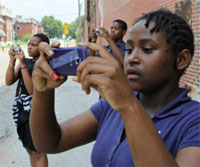Develop a Neighborhood-Community Asset Inventory
Information on how to develop an asset inventory of your neighborhood or community.
Description

An asset inventory is the process of collecting and documenting the positive attributes and features of your neighborhood: both physical things such as buildings and parks, and social assets like residents, businesses, and organizations. This can be done in a number of ways, but hosting events like photographing days, walking tours, mapping tours, and interviews with residents are all ways to take stock of your neighborhood. This information can then be shared to celebrate and serve as a baseline for future efforts.
Related Tools
When paired with other tools, creating a neighborhood asset inventory can contribute to a more connected, prouder, and more marketable community. Think about community cohesion, public art, local prosperity, and healthy vibrant communities. Try combining this tool with:
Community Projects
Add your project
Neighborhood Benefits
Environmental
- Preserved parks, trees, open space, and existing buildings
Social
- Residents becoming aware and invested in neighborhood assets Improved positive public image for your neighborhood
- Can be used in the future for asset-based planning
- Voice given to neighbors and residents about what is important and an asset in their neighborhood
Economic
- New and continued investment in the community
- Targeted specific new neighborhood developments
- New residents and businesses attracted through the new marketing
Get Started
1. Research A neighborhood asset is anything that can be used to improve the perception or the quality of community life. It can be a person, a natural resource, a tool, a physical structure or place, a community service, or a business. Ask yourself a few questions and get an organization or other residents involved to help:
- What is the size of my community? Find more information at the Planning and Urban Design Agency and through their census.
- Who is available to help me do the work? You can involve volunteers, other organizations, students, seniors, etc.
- How much time can we dedicate to this task? Will it be one week, one month, or as much time as it takes?
- What financial resources do we have to support the work? Some resources can be found through foundations, grants, and organizations such as United Way and the Community Builders Network. Southwest Garden Partnered with SLU and Hyde Park Partnered with Rebuild Foundation.
The Asset-Based Community Development Institute offers a guide.
3. Gather Information Determine how to gather information. You can use a paper survey, an online survey, door-to-door surveys, or questionnaires at special events. Determine the kinds of questions you want to ask. Some examples can be found here and here.
4. Present Information Asset inventories do not have to be a list. Some of the most interesting results come from projects that combine the unique talents of residents with an overall goal highlighting the assets. Combining artistic skills such as drawing, photography, graphic design, video, and website development can create exciting results. Achieve this with a community event such as a charrette or community work session, a school assembly, a walking/photography audit, an interview, or photo booth at local event, store, or farmers market.
Related Categories
Sustainability Plan Categories
Project Scale
- Neighborhood
Download This Tool
Developing A Community Asset Inventory Doc (424.92 KB pdf)
Need Help Viewing?
You need a program that can open Adobe PDF files. A free option:
- Adobe Reader can read PDF files